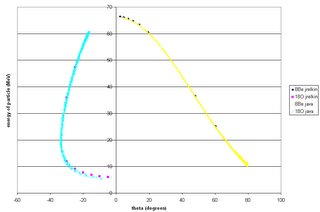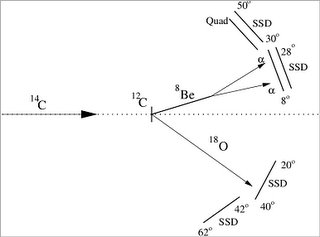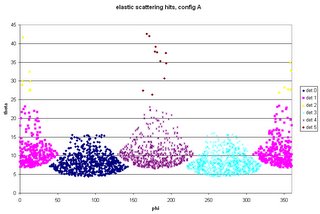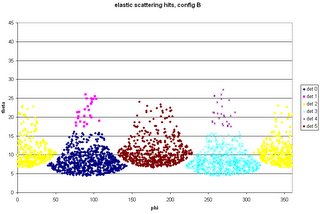The question: When we're measuring the 6.404 MeV level in 18O, does the 6.351 MeV level (if it's populated) add to the width in a measurable way? Do we need to use a thin target to see this contribution to the width? What about contaminants from 13C, 16O--can they be eliminated?
The kinematics: (click on any image to see a larger version, i.e. one in which the text is legible.)

Note that the maximum angle for 18O is 34', so there's no point putting detectors at high angles if they're just meant to be measuring 18O. Also, this plot shows the angle of the 8Be, but we measure its decay products: two alpha particles. We assume that the break-up occurs before the 8Be loses any energy in the target.
The detectors: a bunch of Micron X2 position sensitive silicon strip detectors, plus some 60 ug "pad" delta-E detectors. The initial proposal for the detector configuration is as follows...

It was also suggested to use out-of-plane detectors, in pairs or singly. I tried a bunch of different detector configurations.
Option A:
rd={250,170,170,250,170,170,240,160,160};
thetad={10,15,34,10,15,34,10,15,34};
phid={90.1,0.1,0.1,270.1,180.1,180.1,90.1,0.1,0.1};
Option B:
rd={250,250,170,250,250,170,240,240,160};
thetad={10,23,15,10,23,15,10,23,15};
phid={90.1,90.1,0.1,270.1,270.1,180.1,90.1,90.1,0.1};
Option C:
rd={170,210,210,170,210,210,160,200,200};
thetad={16,11,26,16,11,26,16,11,26};
phid={90.1,0.1,0.1,270.1,180.1,180.1,90.1,0.1,0.1};
(this was the input my simulation took. I don't understand why it was necessary to use 0.1 instead of 0, but it was.)
rd[i] is the radial distance of detector i from the target. thetad[i] and phid[i] are its angles. (The positive-z axis is the downstream beam direction and the x axis is horizontal.) Each detector is oriented so that its normal points to the target. (Makes calculations simple and also minimizes the dead layer effects.) Theta determines whether the detector is forward or backward; Phi determines whether the detector is in plane (0,180) or out of plane (90,270). In configs A and B, I was trying to get the in-plane detectors as close as possible and then fitting in the out-of-plane detectors at positions where they wouldn't be blocked; for config C I tried to make the radial distances pretty much the same for all detectors. (The dE detectors, i=6,7,8, are all set forward 1 cm from their corresponding E detectors, i=0,1,2.)
I tested the efficiency of each configuration using both elastic scattering and the reaction itself. For elastic scattering I used a cross section that was like the Rutherford cross section, normalized to the cross section at 8'. (For each event, a direction was randomly generated, its cross section was calculated, another random number [0,1] was generated, and the direction was accepted if the random number was less than the cross section.) For the reaction, the cross section was calculated from the centre-of-mass angle of the 8Be, using a parametrized fit to Kelly's Fresco calculations: 20*exp(-0.1*theta cm in degrees). This gives values from 11 mb/sr at 6' to 0.1 mb/sr at 51'.
The following figures show the efficiency of the three configurations for detecting elastic scattering.
Config A:

Config B:

Config C:

The efficiency numbers are as follows...
Config A
elastic hits
det 0 697
det 1 577
det 2 13
det 3 678
det 4 536
det 5 11
total 2512
reaction hits
dets 3,6 97
dets 4,7 149
dets 5,8 14
not 3,6 290
not 4,7 114
not 5,8 290
total hits 395
Config B
elastic hits
det 0 715
det 1 26
det 2 540
det 3 705
det 4 27
det 5 557
total 2570
reaction hits
dets 3,6 95
dets 4,7 0
dets 5,8 160
not 3,6 160
not 4,7 264
not 5,8 229
total hits 395
Config C:
elastic hits
det 0 407
det 1 804
det 2 21
det 3 433
det 4 812
det 5 19
total 2496
reaction hits
dets 3,6 143
dets 4,7 140
dets 5,8 25
not 3,6 351
not 4,7 174
not 5,8 326
total hits 505
What the numbers mean: For the elastic scattering sim, it's straightforward: count the number of scattered 14C in an individual detector. (The delta-E detectors are left out entirely, so it's just the X2s that are being used.) For the reaction, it's not straightforward. Since there are three particles being detected and they have different angular distributions, we need to count the number of reaction events that would be detected using the configuration as a whole ("total hits"), using particular pairs of detectors ("dets 3,6" for example), and using particular combinations of four detectors ("not 3,6" for example). Complication: dets 0,1,2 are the X2s behind the delta-E detectors, so a good "dets 3,6" event actually means that the 18O hits det 3 and both alphas hit BOTH the dE detector 0 and the PSSSD detector 6.
From these results, I think Config C is the best option. Its efficiency is 25% higher than Config A's for the reaction, and not much worse for the elastic scattering. Comments on feasability, anyone? Is there any reason why we might want to have detectors at higher angles?
No comments:
Post a Comment